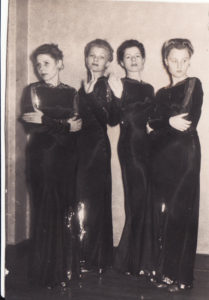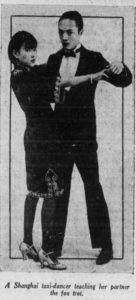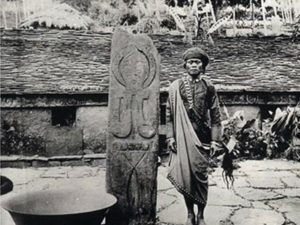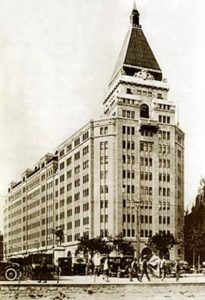Posted: April 15th, 2018 | 1 Comment »
Dr Magnus Hirschfeld was an eminent German sexologist and one of the first outspoken advocates for gay and transgender rights. In 1931 he visited China on a world tour. In Shanghai he met a young Chinese man in his early twenties called Li Tao (or Li Shiu-tong, or Li Zhaotong), also studying sexology and sexual minorities. Despite a significant age gap and cultural differences they fell in love. Li acompanied Hirschfeld to Peking and Beida university (below – Li is the man on the right, on the steps in a dark jacket). Then Li agreed to accompany Hirschfeld back to Germany and live with him. Perhaps surprisingly for 1931 China, Li’s parents were accepting of his sexuality and wished him and Hirschfeld bon voyage when they departed. Li’s father, who was I think an academic too, expressed the hope that his son would become the “Hirschfeld of China”.
Unsurprisingly Hirschfeld fell foul of the Nazis and had to leave Germany for France and resettled in Nice. Li Tao was one of the two named heirs of Hirschfeld. I think Li Tao died in Europe in 1993. To my knowledge nobody has ever written a biography of him.

Posted: April 14th, 2018 | No Comments »
I’ll be talking about old Shanghai and the remarkable Jewish women who lived there Sunday night to the Jewish Historical Society of Hong Kong…
Rarely Mundane, Usually Extraordinary: Jewish Women’s Lives in Shanghai
Sunday evening, 15 April 2018

It’s actually pretty hard to find a Jewish woman in the first half of the twentieth century in Shanghai who was living an “ordinary”, mundane life. From cabaret artists who survived bombs and chorus line dancers who went home at night to
care for their children, through to secretaries who picked the wrong men and bookshop owners who became communist spies, it seems that every Jewish woman in Shanghai at that time lived an incredible life. Their stories were extraordinary.
Now based in London, award-winning author Paul French has lived and worked for many years in Shanghai. His New York Times bestseller, Midnight in Peking, is currently being filmed for television. His previous talk to our community, “Recovering Lost Jewish Lives in China: Yiddish Tears on the Bubbling Wells Road”, just over five years ago to the day, was extremely well received.
Paul is now back in Hong Kong to launch his new book, City of Devils: A Shanghai Noir, a true story of twisted friendships and betrayals set in the 1930s underworld of Shanghai’s casinos, cabarets, dance halls and opium dens.
Sunday evening, 15 April 2018
Time:
6:15 PM for a prompt 6:30 start (new time!)
Location:
Jewish Community Centre, One Robinson Place, 70 Robinson Road, Mid-Levels

Please note that visitors to the JCC are required to register at the Reception desk upon arrival.
We expect the talk to last about an hour. Sorry, no kids under 10.
RSVP:
To reserve your seat at the chat, please contact us at contactus@jhshk.org.
A HK$50 entrance fee will be charged and donated to the JHS Library Fund.
About the Society…
The Jewish Historical Society is a registered society licensed under the Societies Ordinance in the Hong Kong SAR.
The main objective of the Society is to promote a centre for the collection, study and preservation of historical materials relating to the history of the Jews and Judaism in Hong Kong and China.
The JHS has published several volumes on the subject of the Jewish community in Hong Kong and the Jews in China, in addition to promoting the spread of balanced knowledge about Judaic traditions in Chinese academic circles. This has included assisting with the establishment of a Jewish studies programme at Nanjing University and the publication of the world’s first Chinese language “Encyclopaedia Judaica”, copies of which are now in the libraries of almost every university throughout China.
For more information about the publications of the JHS, please contact our librarian at the Jewish Community Centre. She can be reached at 2589-2660 or via email at contactus@jhshk.org.
Posted: April 12th, 2018 | No Comments »
Came across this photograph of a Shanghai dance hostess and partner mid-fox trot in an article on Asian dance hostesses in the Santa Cruz Evening News on Saturday July 1 1933…it’s too evocative not to post….

Posted: April 11th, 2018 | No Comments »
NB: my City of Devils event for the Royal Geographical Society Hong Kong on 12 April sold out rather quickly – so its now 2 events on 12/4 at a larger venue – so you can still get in if u didn’t manage it before …click here for more details

Posted: April 10th, 2018 | No Comments »
Tuesday, 10th April 2018
7:30 pm – 9:30 pm
The Forgetten Tribes of Taiwan
Speaker: Nicolas Grevot

During this session we will hear and discuss Nicolas Grevot’s presentation on “The Forgetten Tribes of Taiwanâ€.
Nicolas Grevot invites you to rediscover the indigenous tribes of Taiwan. What has become of the former Rainbow Warriors? Let’s meet him, at his place, where he will reveal all there is to know about these magnificent people and share his personal collection of impressive tribal artifacts; the largest in the hand of a non-Taiwanese.
Limited seats available!
Chinese History Study Group meets monthly – generally the second Tuesday of each month September through June. Our members select and research topics of personal interest, make brief oral presentations, then engage in discussion with those attending the talk. Each month one or two members discuss their topics.
For a list of future topics and presenters, please contact convener Furkan Erdogan studygroup@royalasiaticsociety.org.cn
Venue
Julu Road, Jingan District
(RSVP neccessary due to limited seats and specific location confirmed following RSVP )
Posted: April 9th, 2018 | No Comments »
China and Siam: Through the Lens of John Thomson
Curated by Betty Yao and Narisa Chakrabongse
Brunei Gallery – SOAS – London
13/4/18-23/6/18

First London exhibition devoted to the Scottish photographer John Thomson (1837-1921) and his photography in Asia will be shown from 12 April – 22 June 2018 at the Brunei Gallery, SOAS. Thomson’s photography of China, Siam (Thailand) and Cambodia was widely praised by his peers and continues to enthuse new audiences today. Widely credited as one of the greatest travel photographers and precursor to photojournalism, Thomson was the first photographer to record Angkor Wat and these striking images are included in the exhibition. The images are from newly discovered negatives held at the Wellcome Library, London.
John Thomson (1837–1921) was a Scottish photographer and writer who set off for Asia in 1862. Over the next ten years he undertook numerous journeys photographing countries including Siam, Cambodia and various provinces of China. Photographs from these journeys form one of the most extensive records of any region taken in the nineteenth century. The range, depth and aesthetic quality of John Thomson’s vision mark him out as one of the most important travel photographers whose influence is still felt today
Posted: April 7th, 2018 | No Comments »

The Royal Geographical Society is delighted to welcome to Hong Kong again well-known Chinese historian and author Paul French to speak on his new book “City of Devils: Shanghai in the 1930s’. In this talk, he gives an exciting account of Shanghai in the 1930s, an era of entrepreneurship, glitter and lawlessness in perhaps the most interesting decade of its storied history.
Members of the RGS, their guests and others are most welcome to attend this event, which is HK$150 for RGS Members and HK$200 for their guests.Â
More details and registration – click
here
Posted: April 5th, 2018 | No Comments »
I ordered it immediately but haven’t had a chance to read yet – a first English translation (from Jane Meizhen Pan and Martin Mertz) of perhaps Chang’s most autobiographical novel, Little Reunions. It’s in bookshops and online at all the usual places. Ilaria Maria Sala has managed to read it and write a review here. However, it Eileen Chang so you might not need a review any more than I did and just need to get it….

A best-selling, autobiographical depiction of class privilege, bad romance, and political intrigue during World War II in China. Now available in English for the first time, Eileen Chang’s dark romance opens with Julie, living at a convent school in Hong Kong on the eve of the Japanese invasion. Her mother, Rachel, long divorced from Julie’s opium-addict father, saunters around the world with various lovers. Recollections of Julie’s horrifying but privileged childhood in Shanghai clash with a flamboyant, sometimes incestuous cast of relations that crowd her life. Eventually, back in Shanghai, she meets the magnetic Chih-yung, a traitor who collaborates with the Japanese puppet regime. Soon they’re in the throes of an impassioned love affair that swings back and forth between ardor and anxiety, secrecy and ruin. Like Julie’s relationship with her mother, her marriage to Chih-yung is marked by long stretches of separation interspersed with unexpected little reunions. Chang’s emotionally fraught, bitterly humorous novel holds a fractured mirror directly in front of her own heart.











